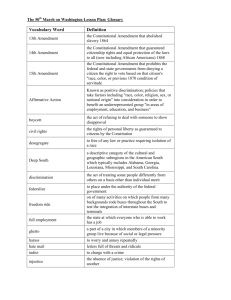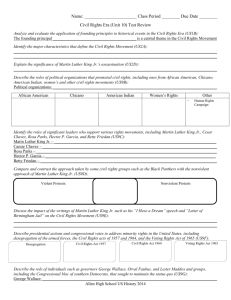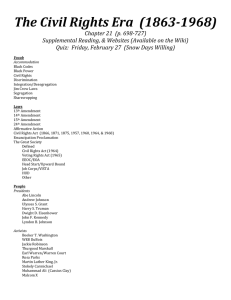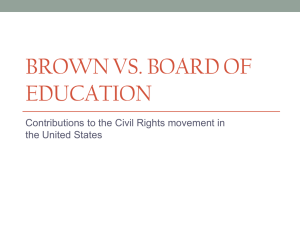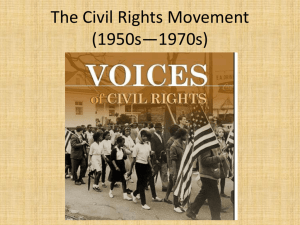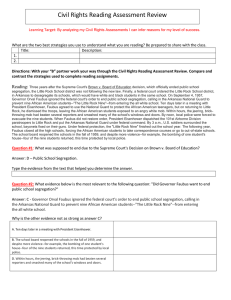Civil Rights - Big Walnut Local Schools
advertisement
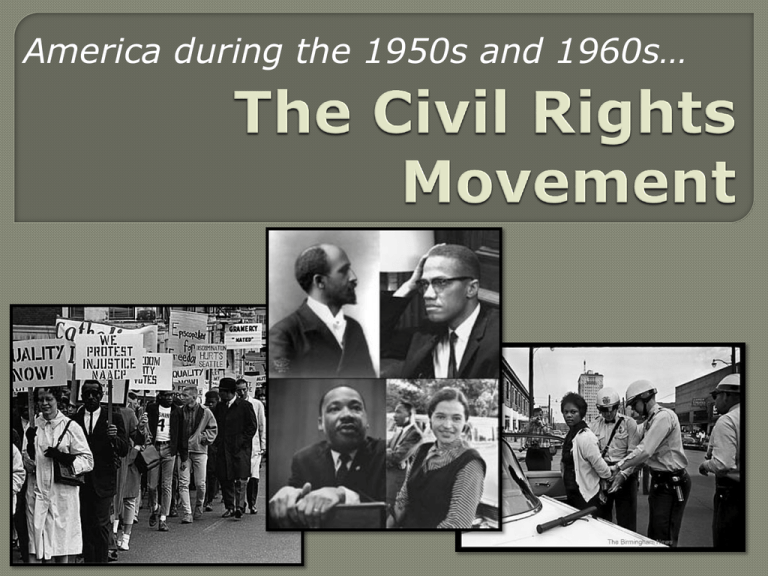
America during the 1950s and 1960s… Civil War Amendments • 13th Amendment: abolished slavery • 14th Amendment: granted citizenship to • 15th Civil everyone born in the United States Amendment: granted the right to vote to all male citizens Rights Act (1875) • outlawed segregation in public facilities • declared unconstitutional in 1883 ruled that “separate but equal” does not violate the 14th amendment led to Jim Crow laws, mainly in the South The Great Migration World War II • increased demand for workers led to more jobs for African-Americans, Latinos and women • nearly 1 million African-Americans served in the armed forces (National Association for the Advancement of Colored People) created in 1909 legal strategy focused on the inequality between separate schools Thurgood Marshall • lawyer who began to argue cases for the NAACP Supreme Court ruled unanimously that school segregation was unconstitutional “In the field of public education, the doctrine of separate but equal has no place.” ~Chief Justice Earl Warren reaction was mixed and particularly negative in the South within a year, more than 500 districts had desegregated Brown II (1955) ordered desegregation “with all deliberate speed” Governor Orval Faubus orders the National Guard to turn away the 9 AfricanAmerican students who will integrate Little Rock Central H.S. (1957) a federal judge ordered Faubus to let the students enter they faced discrimination/abuse when they tried to desegregate President Eisenhower placed the Arkansas National Guard under federal control and ordered paratroopers into Little Rock Faubus shut down Central H.S. the next year, rather than continue integration first civil rights law since Reconstruction gave the attorney general greater power over school desegregation and gave the federal government jurisdiction over violations of AfricanAmerican voting rights December 1, 1955- Rosa Parks refuses to give up her seat after her arrest, leaders of the AfricanAmerican community formed the “Montgomery Improvement Association” and organized a boycott of the buses • Dr. Martin Luther King Jr. is elected to lead the group African-Americans refused to ride the buses for 381 days they remained non-violent late 1956, the Supreme Court outlawed bus segregation Why did this approach work? became used a leader of the movement nonviolent techniques • ex: civil disobedience-refusal to obey an unjust law 1957—with other ministers and civil rights leaders founded the SCLC • purpose: “to carry on nonviolent crusades against the evils of second-class citizenship” • hoped to gain the support of ordinary African Americans 1960—students at Shaw University (N.C.) organized SNCC (Student NonViolent Coordinating Committee) • February 1960-students staged a sit-in at a whites-only lunch counter at Woolworth’s The movement spread and by late 1960, students had desegregated lunch counters in 48 cities de facto segregation-segregation that exists by practice and custom de law jure segregation-segregation by Throughout the 1960s, race riots spread through the north. • July 1964: Harlem • August 1965: Watts • 1967: 100+ cities These riots showed that AfricanAmericans wanted and needed economic equality. Carmichael was the leader of SNCC. With “Black Power” he advocated his organization stop recruiting whites and focus on African-American pride and their own goals.. Oakland, California (October 1966) Huey Newton and Bobby Seale preached self-defense assassination led of Martin Luther King Jr. to the worst urban rioting in U.S. history Kerner Commission-said the main cause of urban violence was white racism Civil Rights Act of 1968-ended discrimination in housing affirmative action- programs that make special effort to hire or enroll groups that have suffered discrimination http://www.youtube.com/watch?v=3 SrIEM8X0qA&playnext_from=TL&vid eos=c0KiY-XOVQs

